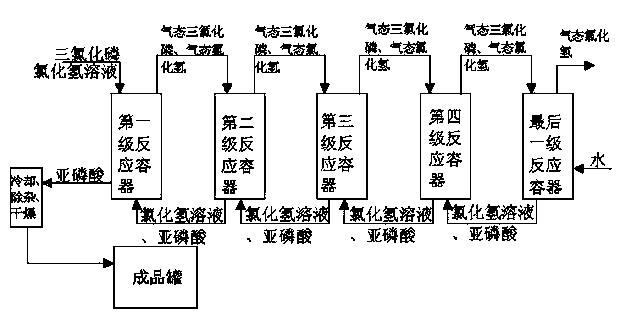Process for preparing phosphorous acid by hydrolyzing phosphorus trichloride
A technology of phosphorus trichloride and phosphorous acid, which is applied in the direction of phosphorous acid, phosphorus oxyacid, etc., can solve the problems of high equipment maintenance cost, large equipment investment, complicated process, etc., to reduce the initial equipment investment, reduce material requirements, The effect of prolonging the service life
- Summary
- Abstract
- Description
- Claims
- Application Information
AI Technical Summary
Problems solved by technology
Method used
Image
Examples
Embodiment 1
[0024] The first-stage reaction vessel is filled with 37% hydrogen chloride solution by mass, and the second, third and fourth reaction vessels are filled with hydrogen chloride solution with a mass percentage of less than 37%, and their mass percentages are sequentially reduced. Phosphorus trichloride is added dropwise to the first-stage reaction vessel, and the phosphorus trichloride reacts with the water in the hydrogen chloride solution to generate phosphorous acid and gaseous hydrogen chloride and release heat. A part of phosphorus trichloride absorbs heat and becomes gaseous, and enters the second-stage reaction vessel with gaseous hydrogen chloride, and takes away part of the heat generated by the hydrolysis reaction; the phosphorous acid in the first reactor is taken out, and is cooled, impurity-free, and dried. After that, enter the finished product tank.
[0025] The gaseous hydrogen chloride and gaseous phosphorus trichloride entering the second-stage reaction vesse...
Embodiment 2
[0030] Refer to Example 1 for the specific process. In this example, the series of reaction vessels are six stages, and each stage of the reaction vessel is composed of 6 parallel reaction vessels. The temperature in each stage of the reaction vessel is controlled at 85°C and the pressure is 0.1MPa. The liquid supplement mode is: water → sixth-stage reaction vessel → fifth-stage reaction vessel → fourth-stage reaction vessel → third-stage reaction vessel → second-stage reaction vessel → first-stage reaction vessel.
Embodiment 3
[0032] Refer to Example 1 for the specific process. In this example, the series of reaction vessels are five stages, and each stage of the reaction vessel is composed of 5 parallel reaction vessels. The temperature in each stage of the reaction vessel is controlled at 75°C and the pressure is 0.05MPa. The liquid supplement method is: water→fifth-stage reaction vessel→fourth-stage reaction vessel→third-stage reaction vessel→second-stage reaction vessel→first-stage reaction vessel.
PUM
 Login to View More
Login to View More Abstract
Description
Claims
Application Information
 Login to View More
Login to View More - R&D
- Intellectual Property
- Life Sciences
- Materials
- Tech Scout
- Unparalleled Data Quality
- Higher Quality Content
- 60% Fewer Hallucinations
Browse by: Latest US Patents, China's latest patents, Technical Efficacy Thesaurus, Application Domain, Technology Topic, Popular Technical Reports.
© 2025 PatSnap. All rights reserved.Legal|Privacy policy|Modern Slavery Act Transparency Statement|Sitemap|About US| Contact US: help@patsnap.com

